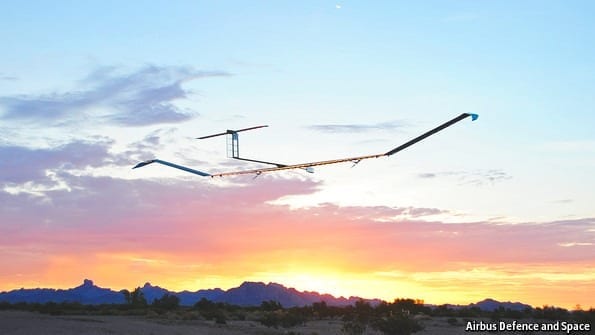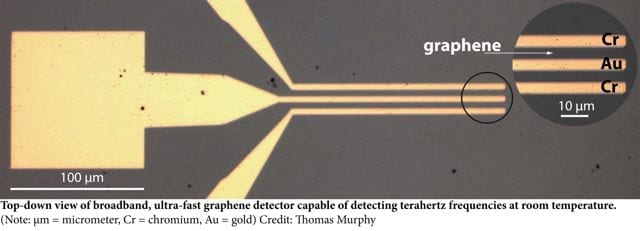
IT TAKES chutzpah to tweet “rockets are tricky” shortly after one you have just launched has deliberately blown itself up.
But Elon Musk, founder and boss of SpaceX, is not a man who lacks self-confidence, and he did just that on August 22nd after the terminal malfunction of one of his company’s Falcon 9 vehicles. That Arianespace, a French rival of SpaceX, announced on the same day that two satellites it had tried to launch to join the European Space Agency’s Galileo constellation (intended to rival America’s Global Positioning System), had entered a “non-nominal injection orbit”—in other words, gone wrong—shows just how difficult the commercialisation of space can be.
If spacecraft are so precarious, then perhaps investors should lower their sights. But not in terms of innovation; rather in altitude. Airbus, a European aerospace company, thinks that developing satellite-like capabilities without satellites is the answer. Hence the firm’s recent trial, at an undisclosed location (but one subject to Brazilian airspace regulations) of Zephyr 7, a high-altitude “pseudo-satellite”, or HAPS for short.
Zephyr (named after the Greek god of the west wind) is actually an unmanned, ultralight, solar-powered, propeller-driven aircraft. But it is designed, just as some satellites are, to hover indefinitely over the same part of the world. With a 23-metre wingspan and a weight of only 50kg, it is fragile and must remain above the ravages of the weather and the jet stream both by day and by night. It therefore flies at an altitude of around 21km (70,000 feet) during daylight hours, and then glides slowly down to around 15km when the sun is unavailable to keep it aloft.
Zephyr (named after the Greek god of the west wind) is actually an unmanned, ultralight, solar-powered, propeller-driven aircraft. But it is designed, just as some satellites are, to hover indefinitely over the same part of the world. With a 23-metre wingspan and a weight of only 50kg, it is fragile and must remain above the ravages of the weather and the jet stream both by day and by night. It therefore flies at an altitude of around 21km (70,000 feet) during daylight hours, and then glides slowly down to around 15km when the sun is unavailable to keep it aloft.
The Latest on: High-altitude pseudo-satellite
[google_news title=”” keyword=”High-altitude pseudo-satellite” num_posts=”10″ blurb_length=”0″ show_thumb=”left”]
via Google News
The Latest on: High-altitude pseudo-satellite
- Meet Britain’s cutting-edge stealth aircraft – that flies at the speed of a bicycleon April 25, 2024 at 3:01 am
Its light weight helps the craft reach dizzying heights. Unlike conventional aircraft, which typically fly between 30,000 and 40,000 feet, Aalto is one of several British ventures blazing a trail in ...
- Stratospheric Zephyr To Be Powered By Amprius 450 Wh/kg Cellson April 18, 2024 at 2:34 pm
Aalto HAPS has purchased Amprius Technologies’ 450 Wh/kg SiMaxx lithium-ion cells for its stratospheric Zephyr UAV. Amprius previously supplied 400 Wh/kg cells for an earlier iteration of the ...
- Amprius Secures Multiple Purchase Orders from AALTO for SiMaxx™ 450 Wh/kg High-Energy Cells to Continue Record-Breaking Flightson April 18, 2024 at 5:37 am
Amprius Secures Multiple Purchase Orders from AALTO for SiMaxx™ 450 Wh/kg High-Energy Cells to Continue Record-Breaking Flights ...
- Amprius Secures Multiple Purchase Orders from AALTO for SiMaxx™ 450 Wh/kg High-Energy Cells to Continue Record-Breaking Flightson April 18, 2024 at 5:37 am
"AALTO is one of Amprius’ long-standing customers, and we look forward to continuing to support its world record high-altitude pseudo satellite missions with our high-energy density cells." ...
- High Altitude Pseudo Satellite Market is projected to exceed USD 301.24 Million, achieving the highest CAGR of 16.9% by 2030on April 9, 2024 at 5:00 pm
High Altitude Pseudo Satellite Market Overview: The High Altitude Pseudo Satellite Market is propelled by increasing demand for cost-effective wireless communication services in remote areas and ...
- High Altitude Pseudo Satellite Market is projected to exceed USD 301.24 Million, achieving the highest CAGR of 16.9% by 2030on April 9, 2024 at 5:00 pm
High Altitude Pseudo Satellite Market Overview: The High Altitude Pseudo Satellite Market is propelled by increasing demand for cost-effective wireless communication services in remote areas and ...
- Aerovironment Shows Small but Mighty Weapons Systems | March 26 2024 | News 19 at 7:30 a.m.on March 25, 2024 at 5:00 pm
Phil Rottenborn with Aerovironment showed Steve some of their small-scale technology, including their upcoming project the high altitude pseudo satellite. Kamala Harris roasted after she claps alo ...
- UAE-based firm & Indian start-up join hands to deliver High Altitude Pseudo Satelliteon March 21, 2024 at 5:48 am
New Delhi: UAE-based Mira Aerospace and Indian start-up VEDA Aeronautics have come together to offer High Altitude Pseudo Satellite (HAPS) solutions designed for the Indian market, both in the ...
- Indian Navy To Procure 'Pseudo Satellites' To Extend Surveillance Capabilityon March 14, 2024 at 7:00 am
(MENAFN- AsiaNet News) Indian Navy has inked a contract for the design and development of an indigenous High Altitude Pseudo-Satellite (HAPS) with NewSpace Research and Technologies (NRT), with an ...
via Bing News









